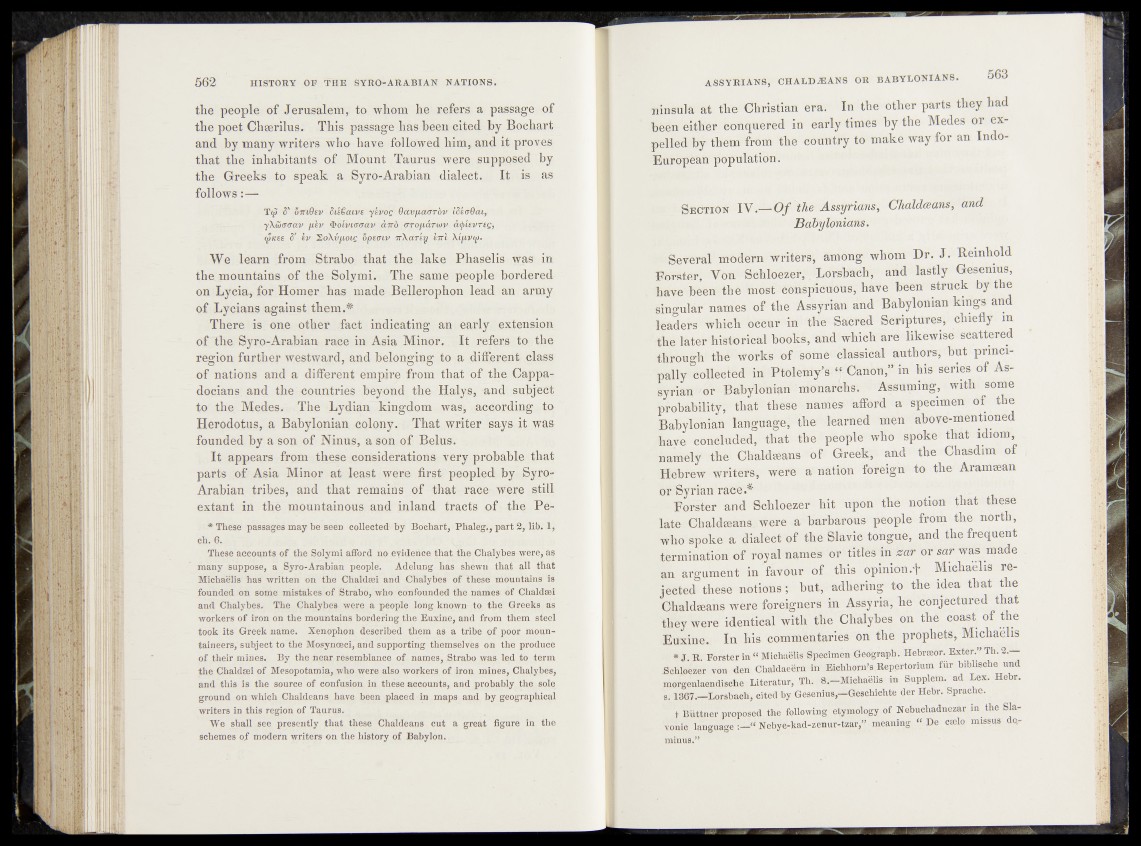
the people of Jerusalem, to whom he refers a passage of
the poet Chaerilus- This passage has been cited by Boehart
arid by many writers who- hay©*, follo'wedjhim, and it? proves
that the inhabitants of Mount Taurus were supposed" by
the Greeks to speak a Syro-Arabian dialect. It is as
follows:—
Tip S' SmQev Sis€atvs ys&o§s ’ '
yXwff<rav f i s y & 6h/i<x<Ta v ,d i r o -
^JK££ S’ iv 2o\vfial£ OpSGlV 1CXdTSy S7TI \lflVijl-
We learn from -Strabo that the lake Phaselis was; in
the.mountains of the Solvmi. The same people5 hordered-
on Lycia, for Homer has made Bellerophon lead rain army
of Lycians against them.*
There is one other Tact indicating' an earlyd .extension
of The Syro-Arabian race in Asia Minor., It refers ;to The
region further westward, and belonging to a different class
of nations and a different empire from that of the Cappadocians
and the countries beyond the Halys, 'an^subje^t
to th© Modes/ The LydianTTdngdom was*," laeqofdj-mg. ;tq
Herodotus, a Babylonian csqlony. That writer says ^.was
founded by a son of Nintis, #son <^|Belus.
It appears from these-considerations wery probable^ that
parts of Asia Minor at least were first- peopled; by.. jSyro-
Arabian tribes, and that remains of that- -race' were still
extant in the mountainous and inland tracts of- the Pc-
* These passages may be seen colleeted-by Boehart, PBaleg*, part 2, lib. 1,
ch. 6.
These accounts of the Solymi afford no evidence that the Chalybes-werej as
many suppose, a Syro-Arabian people. Adelung has shewn that .a ll'th a t
Michaelis has written on the Chaldsei and-CJhailybes o f these mountains5 !is
founded on some mistakes of Strabo, who confounded the name» 'of ChaldSei
and Chalybes. The Chalybes were a people long known- to the Greeks as
workers of iron on the mountains bordering the Euxine, and from them steel
took its Greek name. Xenophon described them as a tribe of . poor mountaineers,
subject to the Mosynoeci, and supporting themselves on the produce
of their mines. By the hear resemblance of names, Strabo was led to term
th e Chaldsei of Mesopotamia, who were also workers of iron mines, Chalybes,
and this is the source of confusion in these accounts, and probably the sole
ground on which Chaldeans have been placed in maps and by geographical
writers in this region of Taurus.
We shall see presently th a t these Chaldeans cut a great figure in the
schemes of modern writers on the history of Babylon. =
#insula at the Christian era. In the other parts they had
ifeh-^Sher conqttSWd in-' early times by the Medes or ex-
pelleST§* A m frbrh %-hd'^ountry to make way for an Indo-
Eurepban population .
W .—Of^the Assyrians, ChaldceanSj and
- 'Babylonians.''
Several mbdfe • white%% among 'whom Hr. J. Remhold
Fo-rMer* Voh"*'ScMb^fefLdrsbdeh,' ah&Hastly Gesenius,
have-been- the ^#^5@n^pieW°us, have -bbfeb sthfick by the
sing®-' names ?o'f tip ^ y T ia n ahd Babylbflian kmgs and
leaders which ^hcur'-in^ f!tl^^*Sh'C<ped ^dri-ptUrbS^-ShSefly m
'-fbe falerbistorical hhb^s, arfd^fech are likeWise^attered
tliroffpi^'th^ works Jo#$%5bi§«dMissidal authoA; hut > prinei-
plaHy^4ollected in Ptblebiy's his series of Assyrian
'or Babylonian'iriOnarcist -'5A^sutoiflt, with some
probability';'’ th at' thfed ii'arl^ afford 'a 'specimen’, of the
Bahytofe» la^guh|d;4&^lear’b e ^ men - above-mentioned
hay«-«nonclude^ *tba*‘ th ^ ^ e ^ ^ a o w p o k te that liiow^
namely the« Chalda^M^of Greek;- and th e1 Cbasdim of
Hebrew writer, Word a' nation to the* Aramaean
o S $ % ^ n r a c te ;* , *' ‘ V
F o r s t e r a n d *S ch lc fe z e r h i t u p o n t h e n o t i o n th a t , t h e s e
l a t e '; G h a ld a e a n sL ,w e r e - a b a r b a r o u s p e o p l e f r o m T h e , n o r t h ,
w h o s p o k e a d i a l e c t o f th O S l a v i c T d n g ^ a n d t h e f r e q u e n t
t e rm i n a t i o n 'o f r o y a l n a m ^ s 'b ^ T i t i e ^ l i l r0cCT or sat w a s m a d e
a n a r g u m e n t i n f a v o u r 0% t h i s f t j p i n i o n . ^ M i c h a e l i s r e j
e c t e d th e s e n o t io n s ;© h u ^ a d h e r i n g t o t h e T d e a t h a t t h e
C h a ld a e a n s w e r e f o r e i g n e r s i k y A s s y r i a ;
they were identical with fhe ^Chalybes' on tne coast of the
Fuxine. In-his commentaries©» the,; pre^fe^i, Michaelis
* J B. Forster in $f MiGhit§lis*§pecim&n«Geo''gpaph'.‘!Hefer8e£Jr. Bxter.” Tb.e.
-Schjoezer von dem —
morgenlaendische * Literatur, 1 Supplem, ad Lex. Hebr.
■ g. 1367.—Lorsbach, cited^y/GesemUS^'Greschicbtfc der Hebr. Spracbe. ,
t Buttner proposed. ,theK follow!^"efemology of Nebuchadnezar in the Slavonic
language:—f‘,Nebye-kad-zenur-tzar,” meaning “ De cselo missus dqr
minus.,f l l |